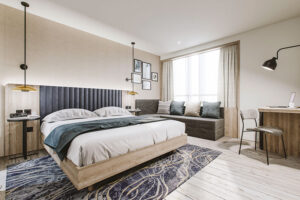The Changing World Of Hospitality Interiors

By Nicola Ball, Associate Interior Designer at KKA (https://kka.studio)
 The world of hospitality interiors is changing. Heineken announced last week that they would be spending up to £40 million on pub upgrades, in a bid to maintain commercial success in an increasingly competitive and diversifying landscape.
The world of hospitality interiors is changing. Heineken announced last week that they would be spending up to £40 million on pub upgrades, in a bid to maintain commercial success in an increasingly competitive and diversifying landscape.
The pandemic has taught businesses the combination of agility and robust contingency plans have proven priceless.
Across the architecture industry we have seen client briefs change at a moment’s notice. Hospitality spaces that were designed for short-term stays were hosting guests for longer periods due to the demands of self-isolation, and thus, weren’t meeting their demands – albeit in the most unprecedented of circumstances. However, we’ve demonstrated the ability to respond with the nimbleness required to adapt when needed.
But, with the resurgence of hospitality in full flow – and a summer of maximum capacity events around the corner – it’s timely to consider how hospitality briefs have changed during this turbulent period.
When designing interiors for hospitality venues near airports, major sporting or music venues, the brief is targeted towards guests staying for a short period. These spaces are perfect for the business professional working away from home, those away on a long weekend, and any others looking for ‘quick-fix’ accommodation that can fulfil their needs.
These venues provide a different experience from longer stay spaces, from the lighting, check-in or food and beverage offering.
Lighting in these spaces is much lower and atmospheric with softer, delicate furnishings that bring an extra layer of comfort to guests. Check-in services are typically automated, coupled with the ability to order convenient room-service, minimising contact with staff so they can get to their workplace, event, or destination more efficiently.
When comparing design of longer-term stays, there is a large disparity in guests’ needs.
In longer stay spaces furnishings and finishes have improved durability, meaning they have an extended lifespan and quality doesn’t deteriorate from overuse. Also, lighting is set to ‘task lighting’, meaning it is brighter and replicates everyday life at home, rather than atmospheric lighting that can lead to over-relaxation. As expected, the food and beverage offering is different too. Rather than ‘quick-fix’ meals, guests are offered holistic menus and partner with local suppliers to offer different dining experiences.
The differences between the two styles of venue are deeply considered, and for a venue to change to meet the demands of the other, they must be very flexible.
During the last two years a number of hospitality venues have been faced with this challenge. The Courtyard by Marriot at London City Airport had to deal with this first hand, with KKAI having to alter its interior plans to meet the demands of longer-term guests having to complete isolation periods after international travel, rather than a quick stop-over.
The venue altered its approach to lighting, check-in, food and beverage offering and finishes, in order to quickly meet the demands of its guests.
Now, with summer round the corner, international travel becoming easier and a full calendar of maximum capacity events taking place, have the considerations of future briefs changed?
Through delivering the Hilton Garden Inn at Silverstone, KKAI have found first hand that there is still a demand for short term hospitality, with the associated considerations. However, certain aspects are being reconsidered.
Wellness is now at the forefront of every design decision. These spaces need to be inviting for guests who are apprehensive about returning to large crowds again. As such, maximum capacities have been reassessed, with management teams including a certain amount of flex within elaborate contingency plans. Also, finishes – across all spaces – are more durable. Due to increased cleaning, antimicrobial fabrics and materials are favoured.
Although we can be excited about returning to original briefs that made hospitality venues a place of escapism, it is important that operators learn from the experience of the last two years and evolve with it – not doing so could have disastrous implications for the hospitality industry.
